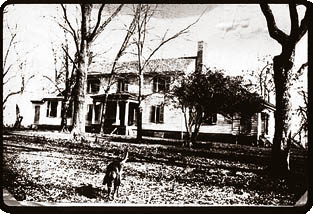Flowerdew Hundred Plantation facts for kids
|
Flowerdew Hundred Plantation
|
|

Wilcox House at Flowerdew Hundred, built 1804, demolished 1955.
|
|
| Nearest city | Garysville, Virginia |
|---|---|
| Area | 1,400 acres (570 ha) |
| NRHP reference No. | 75002030 |
Quick facts for kids Significant dates |
|
| Added to NRHP | August 1, 1975 |
Flowerdew Hundred Plantation is a historic place in Virginia. It started in 1618 or 1619. Sir George Yeardley, who was the Governor of Virginia, was given 1,000 acres of land. This land was on the south side of the James River.
Yeardley likely named the plantation after his wife's father, Anthony Flowerdew. A "hundred" was an old way to divide land in a county.
Flowerdew Hundred was a successful place. About 30 people lived there. They grew lots of tobacco and corn. They also raised animals and caught fish. Sir George Yeardley even paid to build the first windmill in British America here.
Today, Flowerdew Hundred is a private home.
Contents
A Look Back at Flowerdew Hundred
Flowerdew Hundred was one of the few plantations that survived an attack in 1622. Only six people died there. It stayed a strong, private plantation. Many other places nearby, like Henricus, were left empty.
First Windmill and New Owners
The first windmill in English North America was built at Flowerdew Hundred by 1621. It was an English post mill. This type of windmill could turn to face the wind.
In 1624, Abraham Piersey bought Flowerdew Hundred. He renamed it Piersey's Hundred. Piersey's Stone House was the first home in the colony with a strong, permanent foundation. Records from 1624 show about 60 people living there. This included some of the first Africans in Virginia.
Throughout the 1600s, Flowerdew Hundred kept growing. A second settlement was even started. Later, a small town called Flowerdew Towne was formed. But it wasn't very successful.
Ferry and Later Years
After 1720, a ferry boat ran from Flowerdew Hundred. It crossed the James River. A tavern was built there for people waiting for the ferry.
Part of the land was later owned by the Poythress family. In 1781, during the American Revolutionary War, the property was shelled. General Benedict Arnold ordered his soldiers to attack nearby forts. Then they continued to Richmond and set it on fire.
The Willcox Family and the Civil War
The plantation was brought back together by John Vaughn Willcox. He was a merchant from Petersburg. He married the last Poythress family member who owned the land. He bought back other lands that were part of the original grant. In 1804, they built a new farmhouse. It was on a high ridge overlooking the James River.
The American Civil War reached Flowerdew in June 1864. General Ulysses S. Grant ordered his army to cross the James River. He wanted to get around General Robert E. Lee's army. Grant hoped to capture Petersburg, which was important for the Confederate war effort.
The Corps of Engineers built a pontoon bridge across the James River. A pontoon bridge is a floating bridge made of boats or rafts. They built it in just one evening! It was the longest floating bridge ever built at that time. Grant's Crossing held this record until World War II. Grant's army, with three large groups of soldiers, crossed the river in about three days. They were heading to City Point to begin the Siege of Petersburg.
Finding the Bridge Site
In 1986, Eugene Prince and Taft Kiser found the exact spot of the pontoon bridge. They used an old photograph from 1864. A dead branch on a cypress tree in the photo was still there 122 years later. This helped them confirm the location.
The old Willcox house was taken down in 1955. But a magnolia tree planted in 1840 still grows there. A large new house was built on the same spot. The bald cypress tree that helped anchor the pontoon bridge is also still there. In 1978, a new windmill was built on the farm. It was like the original English post mill. This windmill has since been sold and moved away.
Over the years, the name Flowerdew Hundred has been spelled in many ways. Other names for the property include Piersey's Hundred and Hood's. It is listed on several historic trails. These include the Captain John Smith Chesapeake National Historic Trail.
Today, the Justice family owns and runs Flowerdew Hundred Plantation. They have large farming operations in several states.
Exploring the Past: Archaeology
The original 1,000 acres of land have over 60 archaeological sites. These sites show signs of human activity from ancient Native American camps to homes from the 1900s.
Archaeological digs at Flowerdew started in the late 1960s. They continued until 1995. During these digs, archaeologists found more than 500,000 artifacts. These items are now kept at the University of Virginia.
One special artifact found is the Prince of Orange medallion. It was made in 1615. Only three other such medallions have been found. One was found at Historic Jamestowne. Another was found in a Native American grave in Rhode Island. The last one is at the British Museum.
The Flowerdew Hundred Foundation
In 1975, David A. Harrison III, who owned Flowerdew Hundred, started the Flowerdew Hundred Foundation. This foundation ran a museum. It also gave tours of the plantation and the rebuilt windmill. The foundation closed in 2007. The windmill was given to a museum in Texas. It was taken apart and moved there in 2010. After the foundation closed, the plantation was sold.



